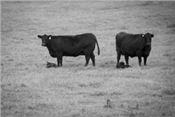|
Managing Calf Stress Helps Improve Weaning Outcomes

On-farm weaning can lead to healthier calves, who have lower stress levels come sale time.
Photo by Aimee Nielson, UK agricultural communications
LEXINGTON, KY.
The most stressful period in a calf’s life is probably at weaning. Until that time, a calf relies on its mother for just about all its needs – nutrition, protection, comfort. Although producers can’t completely eliminate stress during weaning, helping cattle deal with it can go a long way.
“It’s important that we think about weaning as a period of time, rather than a single day,” said Katie VanValin, extension beef specialist for the University of Kentucky College of Agriculture, Food and Environment.
Some producers separate the calves from the cows, load them up, head to the sale barn and call those calves weaned.
“Those calves arrive at the sale barn bawling and then get put into groups with calves from other farms,” VanValin said. “They eventually make their way through the auction process and go to a feedlot out West in a process that takes a few days.”
On that trip to the feedlot, calves may be exposed to pathogens that can cause illness. They must learn to eat and drink from unfamiliar waterers and feed bunks. Most of the time, they are eating an unfamiliar diet.
“All of these things are stressful to calves on their own but combine them all together and you have some seriously stressed out cattle,” she said. “Abrupt weaning can actually increase the risk for developing a respiratory disease.”
Another way to approach weaning is to start the process on the farm. It won’t be completely stress free, but it can offer less risk for disease in the long run. Fenceline weaning is when cows and calves are in separate areas, but have the ability see and hear each other and have nose-to-nose contact.
“Fenceline weaning can get cattle through the initial stress of being away from each other,” VanValin said. “It also limits the comingling and transportation stress and limits their exposure pathogens during this stressful time.”
During weaning time on the farm, producers need to focus on nutrition. They should encourage cattle to eat and offer a high-quality grass or legume-grass mixture hay for calves in dry lots. Grain supplements can increase the nutrient density of every mouthful of feed during this time.
“If you feed supplements each day, by hand, you’ll be able to visually assess each calf and take note of which ones are not coming to the bunk,” VanValin said.
Another advantage of on-farm weaning is the ability to take advantage of new marketing opportunities such as the CPH-45 program. CPH-45 is Kentucky’s Certified Pre-Conditioned for Health program that has a proven record of improving the quality and value of Kentucky beef cattle. VanValin stressed that preconditioning allows producers to separate the stress of weaning from the stress of the auction process.
“I encourage you to assess your weaning program,” she said. “Is it a one-day event or a period of time for your operation? Are you leaving money on the table by rushing calves to market?”
Although the process may seem daunting, decreasing stress during the weaning period may make for a better calf come sale day. ∆
|
|